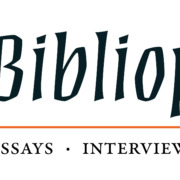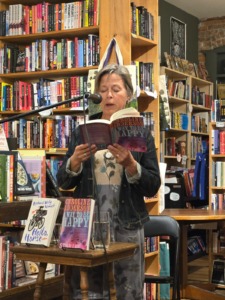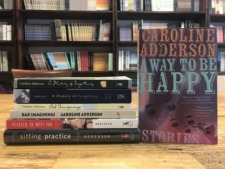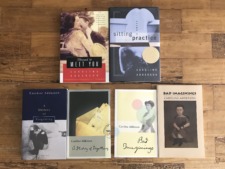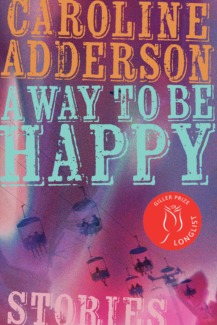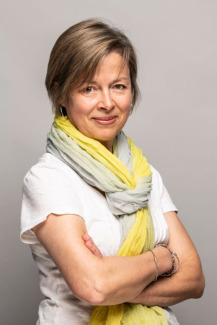The Bibliophile: Honouring the Reading
Want to get new excerpts, musings, and more from The Bibliophile right away? Sign up for our weekly newsletter here!
***
A writer is never really writing alone. You learn from everything you read and this is a way of honouring that reading.
—Caroline Adderson
Facebook is, as I said last week, a useful tool for a flagellant, but it’s also useful at alerting us on occasion to what we’ve forgotten. So even though I knew our twentieth anniversary or birthday or whatever you want to call it was quickly upon us, what I was no longer sure of was the exact date. I remember that the day that the boxes of Salvatore Ala’s Straight Razor and Other Poems were wheeled through the door of our first bookshop at 1519 Ouellette Ave. by the Canpar delivery man was only a day or two before Thanksgiving, 2004. I remember the moment that we carefully cut through the packing tape and pulled back the flaps, to be awed by the unvarnished beauty of all of those straight razors looking back up at us. I remember closing the shop for the rest of the day to celebrate, and heading out with Dennis Priebe, my production manager, fellow bookseller, and friend, and Sal to celebrate. And I remember carrying that book with me all Thanksgiving weekend, from family function to family function, so proud I was (and remain) of this first publication.
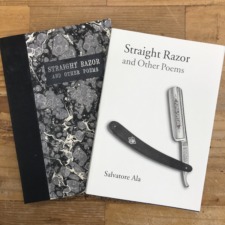
Photo: Straight Razor by Salvatore Ala, the first book of many to come from Biblioasis. In paperback and a limited edition hardcover.
What I didn’t remember was the date. But Facebook is indeed very good at that, and this week popped up with a memory telling me that it was October 7. So, now, it seems, we are officially twenty! Not as old as those geezers at ECW, who will be celebrating their fiftieth anniversary this fall at a party with musical performances by Dave Bidini, Rik Emmett, and others: Allied Forces! Now that makes me feel old! (There’s a great profile of ECW here, for those interested in reading more.) But old enough. Twenty years, I’ve joked perhaps once too often, is the equivalent of a life sentence; I’m not sure if or when I’ll ever get paroled, but what I am certain of is that I don’t have another thirty in me. The longer I do this, the more amazed I am by those who’ve done it far longer.
Our next books after publishing Salvatore Ala’s Straight Razor and Other Poems were a series of limited edition short fiction chapbooks, the first three of which were by Leon Rooke, Clark Blaise, and Caroline Adderson. Caroline’s contribution, published in January, 2005, was a short story called Mr Justice, which was later gathered in her second collection, Pleased to Meet You. I’ve already written in an earlier installment of The Bibliophile about my discovery and love of Caroline’s work, but she’s also one of the writers we’ve been associated with longest. I still don’t quite understand how it is that she’s not among our most celebrated writers. But the great thing about that is that her work is still there, waiting to be discovered. So, please, on this Thanksgiving weekend, do so: trust me when I say it’s one of the easiest ways you can make yourself happy.
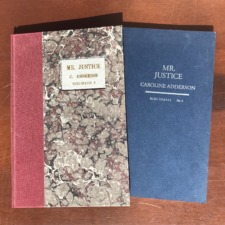
Photo: Mr Justice by Caroline Adderson, in a limited edition paperback and hardcover. No. 4 in the Biblioasis Short Fiction Series, readied for the press by John Metcalf.
Last week, I was able to spend a couple of days with Caroline as she toured down the 401, launching her new collection, A Way to Be Happy, alongside Richard Kelly Kemick’s Hello, Horse in Windsor and Toronto before she headed off to Ottawa and Montreal. The interview I recorded with Caroline and Richard was excellent, and, if I ever find the time to transcribe it, might make a future installment of this newsletter: the conversation ranged widely, from writing across genres, to what people get wrong about short fiction, to where their ideas come from, to the role of humour in both authors’ work, to what they each wish they’d known when they started writing. In the meantime, I thought I’d include an earlier interview we did with Caroline, in anticipation of the launch of A Way to Be Happy.
Dan Wells,
Publisher
***
An Interview with Caroline Adderson
Can you tell me a little bit about yourself?
I’m a writer of all kinds of things, predominantly fiction for adults, both novels and short stories. I also write for children and have published one non-fiction book. But my real love is short stories.
As I read A Way to Be Happy, I was reminded of some great writers, including Alice Munro, George Saunders, and Claire Keegan, and was excited by your literary allusions to Emily Dickinson, Anton Chekhov, and more. Can you talk about some of your literary influences, and the role they play in your work, particularly in A Way to Be Happy?
I sometimes feel like I’m moving against the current. The trend today seems to be autofiction and writing from one’s lived experience. But I’ve never really done that. To me, writing is an act of empathy. I’m interested in trying to feel what it is to be someone entirely different from me. As I’ve gone along in my career, I’ve felt the need to do this even on a sentence level, to move past my own words and incorporate, or riff on, other texts. I wouldn’t say that the writers that are referenced in A Way to Be Happy have influenced my prose style per se. But since you mentioned Alice Munro, she definitely has. Whenever I’m faced with a technical problem, I turn to Munro.
When I read, I read with a pencil, underlining the sentences I admire, then transcribing these random sentences in a notebook. I often turn to this list for inspiration. I’m always encouraging students to do this too, so that they might pay more attention to the words they use and feel what style is from the inside, which is what happens when you copy something out.
Most of the stories in A Way to Be Happy contain an element of inter-textual experimentation. Sometimes it’s a little puzzle. Sometimes it’s the title, such as “All Our Auld Acquaintances Are Gone.” It’s not like Robbie Burns inspired the story, but the reference, I hope, sets up an ironic and even melodic line that runs through it. If the reader happens to recognize a reference, then the implications of that text are imported into the story. It’s really something I’m doing for myself, to keep growing in my craft, to keep learning, and to be part of “literature” in general. A writer is never really writing alone. You learn from everything you read and this is a way of honouring that reading.
The empathy for your characters is tangible, which is a unique feat given how varied your work is, and how many of your characters are ones that aren’t always visible—or focalizers—in literature. Can you tell me about the experience of inhabiting perspectives, voices, and experiences other than your own, and your approach to finding empathy for such a wide cast of characters?
I don’t find it very hard. I’m one of those people who weeps at the news and lies awake at night worrying about people I have no personal connection to. Part of being a decent human being is caring about others. And when you care about other people, you’re curious about them, curious about how they live, and how they think and feel. The pandemic was, among other things, great for practicing this. I found myself challenged by opinions I found repellant and divisive, and had to remind myself that I had these writerly skills. What if I opened my heart? What if I tried to understand why they think that way? What happened that put them in that position? That’s what I’m trying to do on the page, which is easier than in real life!
You’ve mentioned in a previous interview (with The Artisanal Writer, 2021) that for you, the most pleasurable aspect of writing is the visitation of the idea and the second is revision. When writing A Way to Be Happy, were there any stories inspired by a particularly memorable idea? Any first drafts you especially enjoyed revising?
Spoiler alert! The story “Charity” was one. It was, in a way, a gift. A friend of mine had a bone marrow transplant then, several years later, met his donor, a lawyer in New York City. Of course, he asked his donor why he’d signed up. It turned out that he didn’t even remember doing it. He went to a Jewish high school; as part of their religious education, they had to do a mitzvah. He was completely surprised when the call came so long after the fact. I thought the forgetting was pretty interesting. The idea of charity is, too, because the person who performs a charitable act definitely gets something from the transaction. Eventually I started thinking about a character whose forgotten good deed is actually the very thing that saves his life. So that was “the idea”. Then I had to figure out who this person was and what his background was like. I thought of Quoyle in Annie Proulx’s The Shipping News, the first page of which I teach in a class on beginnings. He’s this hapless guy who Proulx intricately describes without ever actually saying what he looks like. I named Robbie after him. But as I was writing, Proulx began to unconsciously morph into Prufrock. At first it was just the sound of the two names, but then I realized there were other similarities despite Prufrock being at the end of his life and Robbie at the beginning. At that point I began to use the poem more deliberately to influence the prose. In earlier drafts of the story, I wove whole lines throughout it. I thought it was really clever until I gave it to friends to read and they said it was annoying and distracting. In subsequent drafts, I excised, and excised, and excised. There’s a lot still there but it’s embedded so deeply now its effect is mainly in the rhythm of the sentences. I love working like this, moving the words around and playing with the language, trying to get it to do something beyond just tell the story.
In various stories, you make reference to distinctly Canadian stores like Winners and La Vie en Rose, which allows some readers to place the characters in Canada immediately. At the same time, a reader unfamiliar with these brands can piece why they are mentioned. When crafting a story, do you consider how your reader experiences piecing together the details? And perhaps more broadly, what bearing does the idea of an anticipated reader have on your work?
Unfortunately, not very often. I think I’d be a more successful writer if I actually considered who in the world would want to read about these people. I’m writing for the characters. I feel it’s my duty as a writer to tell, as truthfully and accurately as possible, what happened to this person who does not, in fact, exist. What a reader will make of it, I only think about it after the fact. As in: What?! You’re repelled?
Lastly, what are you reading now?
I’ve decided that I only want to write novels that are two hundred pages or less, so this year I’m only reading novels that are two hundred pages or less. I’m discovering and rediscovering all these wonderful books based on this rather arbitrary criterion. The Vegetarian, by Han Kang. Fantastic. I reread Elke Schmitter’s Mrs Sartoris. I met her at a festival years ago. Nadine Gordimer’s The Late Bourgeois World. Penelope Fitzgerald. I’ve read everything by her and am working my way through her oeuvre for the third time now. Jamaica Kincaid’s Annie John. Oh, I loved Ivana Sajko’s Love Novel, which Biblioasis published. Mary Robinson’s Ha!. I’d never read her. It was just a scream, and I love punctuation in titles. Sarah Bernstein’s Study for Obedience. There’s a very interesting Spanish book by Andrés Barba, called Such Small Hands, about murderous girls in a convent orphanage. James Welch’s Winter in the Blood was wonderful. Julie Otsuka’s The Buddha in the Attic. It’s told in second person plural from the point of view of Japanese picture brides. Mrs Caliban was fun. William Maxwell’s So Long, See You Tomorrow. A brilliant, brilliant book. I reread The Emigrants by W. G. Sebald. I could go on and on . . .
***
In good publicity news:
- Comrade Papa by GauZ’ (trans. Frank Wynne) was reviewed in the New York Times: “Comrade Papa incorporates many small shards of history and storytelling into an overall gleaming mosaic.”
- A Case of Matricide by Graeme Macrae Burnet was reviewed in the Spectator: “A Case of Matricide demonstrates literary talent of the highest order.”
- CBC Books’ “Fall Reading List” included The Pages of the Sea by Anne Hawk, A Way to Be Happy by Caroline Adderson, and May Our Joy Endure by Kev Lambert (trans. Donald Winkler).
- The Hollow Beast by Christophe Bernard (trans. Lazer Lederhendler) was named a finalist for the Governor General’s Award for Translation.
